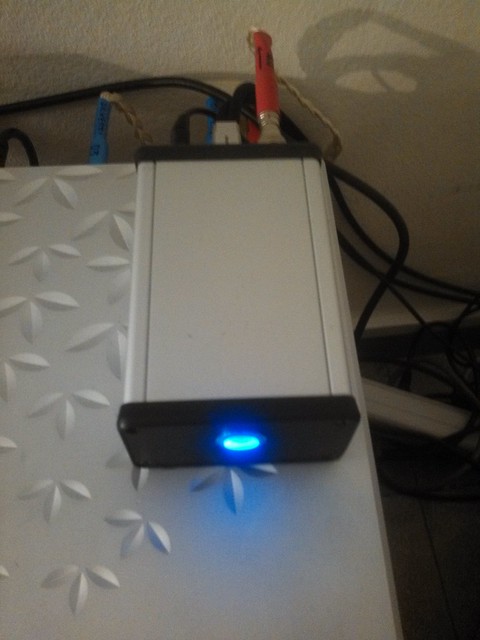The Ciunas USB/SPDIF converter is one of the two products, built by JKenny, belonging to the Ciunas line. While the Ciunas DAC, which I reviewed a while ago, is a stand alone USB DAC, the USB/SPDIF converter is aimed to take the usb signal from a computer, and feed it to DAC’s accepting SPDIF protocol, through a coaxial connection.
Ciunas devices share the USB receiver design, based on the Amanero interface, aiming to exploit it to its limits. They draw power from a LiFe battery, much cleaner than the USB power line.
Context Elements
I have been mainly using the Jkenny Ciunas USB/SPDIF with the Silver.fi D3 digital coaxial cable, in order to connect it with my current two DAC’s, AMR DP-777 and the April Music Eximus DP-1 (which I rebought).
Both DAC’s also have usb input, for which I used JCAT USB cable, as well as the cheaper Lindy and Belkin Gold cables.
The rest of the gear involves Stax Omega 2 Mk1 and SR-Lambda Nova Signature headphones (with a SRM-007t amplifier), and the Mordaunt Short Performance 6 speakers, amplified by my Electrocompaniet integrated.

Sound Impressions
The first thing emerging from my tests involves how differently the two DAC’s react to the coax signal coming from the Ciunas.
Specifically, the AMR reminded me the way it sounded when I tested it with the Audiophilleo 2, almost one year ago. The sound is very polished, the instruments are very clearly portrayed and the soundstage is very wide. By converse, there is some lack of midrange energy, as if the music fails to involve the listener fully.
This is in opposition to when the AMR is used with USB cables. With the JCAT, the sound becomes almost ‘aggressive’, emotional, very involving and capable of high detail retrieval. Using the other two usb cables, instead, the sound loses detail compared to both the JCAT and the Jkenny configurations, but is still warmer than when using the Jkenny interface.
My opinion is that the sound signature shown by the AMR and the Jkenny is caused in equal parts by AMR own coax input, by the Jkenny, and for a lesser percentage, by the Silver.fi D3. This is because the DP-777 shows the same signature with both the Audiophilleo 2, and using a Hiface 2 usb ‘pen’ converter with a Belkin Synapse Platinum coaxial cable, which is regarded as one of the most analogue sounding digital cables.
These combined experiences, strengthen my idea that a DAC like the DP-777 should really be bought to be used with USB (and a great usb cable) .
With the Eximus DP-1, things are a bit different. The DP-1 is an intense sounding DAC. It’s vivid, thick sounding and has a beautiful midrange. When fed by its own USB, it’s slightly darkish.
The DP1 has a USB receiver which is basically a Stello U3 (stand alone usb/spdif interface by the same manufacturer), with a separate power source in order to not use the USB power line.
In the past, I owned a Stello U3, and compared to other devices (such as the Audiophilleo, or the Antelope Zodiac Gold own USB converter), I found it darkish, blurry and average sounding.
After switching from listening the Eximus from the USB to the Ciunas + Silver.fi cable, I was surprised by the entity of the improvement: unlike the AMR, the Eximus retains its thick, analogue sounding nature, with its almost magical midrange, there is a huge increase in soundstage width, sense of instrument separation, and detail retrieval.
In this case, the only trade-off is given by some occasional sharper ‘s’, ‘t’, ‘tch’ with certain singers, but they are only hearable without sounding brash. This occurs mainly with recordings / files that aren’t very good.
Conclusions
The Ciunas USB converter is a great interface for the price. While its strong jitter rejection can translate in more treble quantity, thus potentially making a DAC less forgiving over certain recordings, it gives several benefits throughout the whole sound spectrum. I don’t have a Metrum Octave anymore, but I am sure it would be a fantastic pairing, with the Jkenny being capable of magnifying the Metrum’s detail rendition, coupled with the DAC’s warm tonality.
In general, apart from the specific case of AMR, I would advice towards using it with any warm sounding DAC around, and then further tune the sound with the coaxial cable if necessary.
I would likely avoid using it with more edgy DAC’s like the Audio-gd NFB-9.
In the end, the fundamental phylosophical difference I found between the Ciunas DAC and the Ciunas USB/SPDIF converter, lies in the fact that the Ciunas DAC wants to be an affordable, stand-alone solution that tries to be the best bang for the buck. The Ciunas USB interface, instead, is more interesting for the high-ender audiophile, since it opens up several combinations, and can be used with DAC’s that don’t have the cost constraints that drove the Ciunas DAC design.


